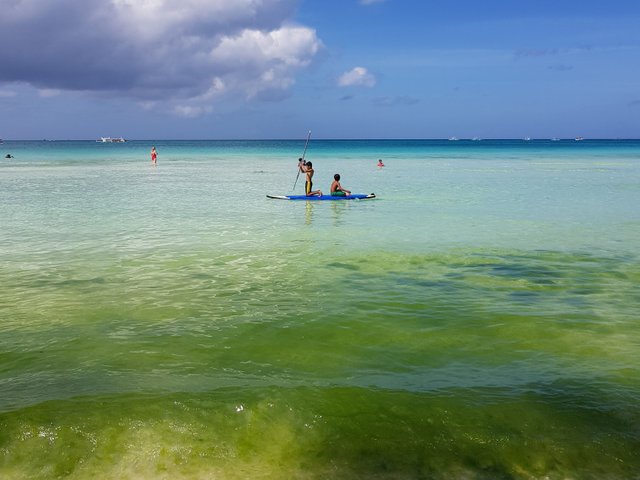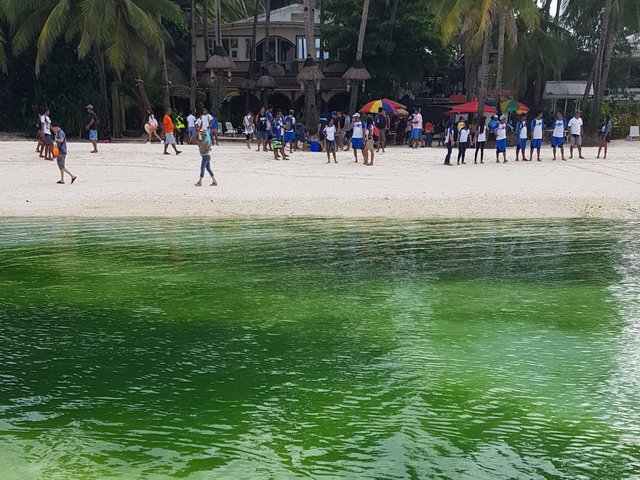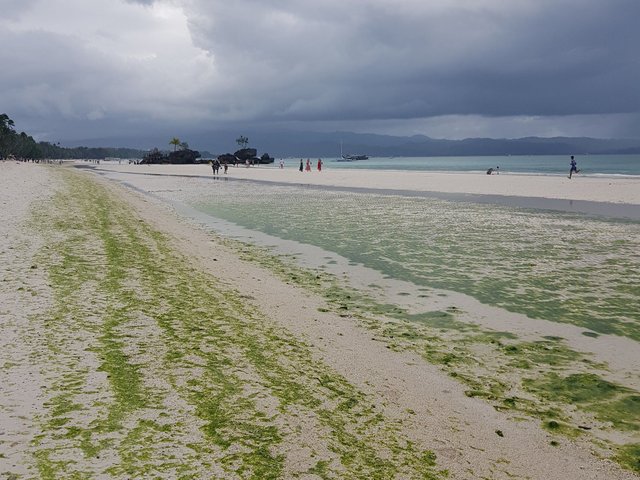What’s Up With the Green Algae Phenomenon in the 'Cesspool' That is the Boracay Island?
My ideal beach destination is one with the white sand, the clear waters, the calming winds, the right amount of sunlight, and only visited by a few people. And when I was in Boracay Island last weekend, where I got to see one of the most beautiful sunsets I have ever laid my eyes on, I was a bit disappointed for one thing: the moss along the shoreline of the White Beach.
 All photos in this post are mine
All photos in this post are mine
This is not the first time that green algae appeared before my eyes in my visit in the famous island. Last year in August, I saw its presence in the beach strip but not as serious this March.
One could say so quickly that the green algae is a product of human activity or pollution, given that Boracay has been infiltrated by severe commercialization which could have effects in sanitation and environmental controls. The common thought is that Boracay as an island is not as pristine and clean as it was before, which is true, making it easy for visitors to conclude that all the ugly sides – let’s admit it, the green algae is unflattering – in the island are caused by the surge of visitors.
But what’s the cause of this, really? Does tourism have to do with the presence of green algae in the waters of Boracay?

Curious, I asked a friend who is based there for a long time when we met one night. He said that the green algae, in all stations, have always been present in the island even before Boracay got global attention as long as 35 years ago. They usually come out during the hot season, he added.
This is what the experts say too, that green algae are a natural occurrence in the island.
But as to the quantity or extent of the presence of green algae, it is not purely natural: the sewage and wastewater management practices of the surrounding businesses contribute to the green algae’s size and life.
A study conducted by conservation group Global Coral Reef Alliance revealed that the presence of green algae along Boracay’s shoreline during the calm season is a strong indicator of very high nutrient pollution typically found right around sewage outfalls.

“The algae that bloom along White Beach in the calm season, bright green species of Chaetomorpha, Ulva, and Enteromorpha, are such strong indicators of very high nutrient pollution that they are typically found right around sewage outfalls,” the GCRA wrote in its report in 2007.
“Along White Beach they bloom every calm season, but die back in the rough season because waves dilute nutrients to lower levels and wash away the algae and the suspended sediments reduce the light levels. Although the problem appears to have gone away, the impacts will quickly become visible again in the next calm season.”
It further noted that “the algae blooms along White Beach have not gone away. The seasonal blooms are due to the uncontrolled explosion of population growth in the interior of the island, whose sewage is not connected to the sewage system. Septic tank discharges maintain very high nutrient levels in the groundwater, which are flowing into the sea at every low tide.”
Meanwhile, Japan International Cooperation Agency (JICA) reported in 2015 that the “direct discharge of untreated waste water near the shore brings about poor water quality level that consequently results in frequent algal blooms and coral reef deterioration.”

That is pretty much it. While green algae is naturally occurring, the local businesses play a role in the presence of moss at the white sand beach, also having an environmental impact with their mismanagement of sewage and wastewater treatment.
Should the green algae stop you from visiting Boracay Island? If you ask me, not really.
It’s still one of the best beach destinations in the Philippines, albeit it has to undergo rehabilitation after being dubbed as a cesspool – which is just right so that the businesses will have to act on their incorrect ways.
It really deterred me from visiting the island. I've watched a documentary about it a few years ago and Boracay became the least of my list of places to visit. I promised to myself that until the island's waste is not properly managed, I will not set foot in that island. I will not support an unsustainable tourism.
Good thing it has reached the President's attention.
I hope govt can find a solution to this😔😔
Congratulations @dioncrediblehulk! You have completed some achievement on Steemit and have been rewarded with new badge(s) :
Click on any badge to view your own Board of Honor on SteemitBoard.
For more information about SteemitBoard, click here
If you no longer want to receive notifications, reply to this comment with the word
STOPI hope the government rehabilitation plan in Boracay could somehow help this problem. We never know how severe the damage it will cost if it won't be solved this time.
In a way, it will. When the sewage treatment and wastewater management systems of the local businesses are ironed out, soon the algal bloom would not be that bad. But that would take a long while.
I never been to Boracay yet but it’s one in our bucket list now I am discourage because it often feature in the news too. Thanks for sharing @dioncrediblehulk.
You can still come without the algae since it is only seasonal!
I have decided not to go now. Whoever is the cause of this should pay highly for destroying nature for profit. How did it even get this bad? No one watching?
The local government unit and government agencies concerned did not enforce the requirements on the local businesess particularly in sewage treatment. It got so bad but finally the Philippine President noticed it.